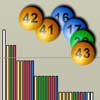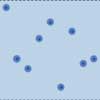Submitted by david on Fri, 11/01/2008 - 5:54pm
The Premier League is the main English football league, with 20 teams each playing a home and away against each other team making, 38 matches for each team in a season, and 380 matches altogether.
Submitted by david on Fri, 11/01/2008 - 5:46pm
 The UK National Lottery began on 19th November 1994 and there had been 1242 draws up to 20th October 2007. The jackpot prize is won by choosing in advance the 6 numbers drawn from a set of balls numbered from 1 to 49.
The UK National Lottery began on 19th November 1994 and there had been 1242 draws up to 20th October 2007. The jackpot prize is won by choosing in advance the 6 numbers drawn from a set of balls numbered from 1 to 49.
Submitted by david on Mon, 03/12/2007 - 11:47am
Luck or skill? suggested using the average number of points per match as an estimate of an underlying quality measure, leading to confidence intervals and uncertainties about ranks. Here we discuss a simple mathematical model that gave rise to those results.
Submitted by david on Wed, 28/11/2007 - 4:18pm
Premier League showed how the points in the Premier League table developed over the 2006-2007 season, but what distribution of points would you get by chance alone?
Submitted by david on Tue, 20/11/2007 - 12:25pm
 League tables are used for football teams, schools, hospitals, songs, films and everything else that can be ranked in some way. But do they mean anything? How much are the rankings just due to chance? We can explore these ideas using probability theory. We would all hope that the UK National Lottery is unbiased so that any ball is just as likely to be chosen as any other. Even so, making a ball league table based on their frequency of appearance provides many little surprises - surprises that could easily be misinterpreted in league tables presented in other contexts. Start on National Lottery - Overview , play with the animations, and go on as far as your maths will allow!
League tables are used for football teams, schools, hospitals, songs, films and everything else that can be ranked in some way. But do they mean anything? How much are the rankings just due to chance? We can explore these ideas using probability theory. We would all hope that the UK National Lottery is unbiased so that any ball is just as likely to be chosen as any other. Even so, making a ball league table based on their frequency of appearance provides many little surprises - surprises that could easily be misinterpreted in league tables presented in other contexts. Start on National Lottery - Overview , play with the animations, and go on as far as your maths will allow!
Submitted by david on Fri, 16/11/2007 - 4:54pm
 The Premier League is the main English football league, with 20 teams each playing a home and away against each other team making, 38 matches for each team in a season, and 380 matches altogether. Teams are awarded 3 points for a win, 1 for a draw, 0 for losing, and the league position is decided on total points, with equal points decided by goal difference (goals for minus goals against). At the end of the season the bottom 3 teams are relegated.
The Premier League is the main English football league, with 20 teams each playing a home and away against each other team making, 38 matches for each team in a season, and 380 matches altogether. Teams are awarded 3 points for a win, 1 for a draw, 0 for losing, and the league position is decided on total points, with equal points decided by goal difference (goals for minus goals against). At the end of the season the bottom 3 teams are relegated.
Submitted by david on Wed, 07/11/2007 - 5:31pm
National Lottery Level 3 showed how the standard [math]\chi^2[/math] goodness-of-fit statistic could be adjusted to allow for non-independence induced by the need to have exactly six unique numbers appear at each draw.
Submitted by david on Wed, 07/11/2007 - 5:28pm
 In Lottery Expectations we looked at the observed and theoretical distributions for the total count of times each number has come up, and the gap between a number's appearances. Here we explain the mathematics behind the theoretical distribution of counts, and how to check for true randomness, and derive the theoretical distribution for gaps.
In Lottery Expectations we looked at the observed and theoretical distributions for the total count of times each number has come up, and the gap between a number's appearances. Here we explain the mathematics behind the theoretical distribution of counts, and how to check for true randomness, and derive the theoretical distribution for gaps.
Submitted by david on Wed, 07/11/2007 - 4:08pm
 National lottery shows how many times each of the numbers has come up in the main National Lottery draw, and what were the gaps between appearances of each number. Here we look at whether the observed distribution of the number of times each of the 49 numbers has come up fits with what would be expected with a truly random draw, and whether the gaps also correspond to what might be expected.
National lottery shows how many times each of the numbers has come up in the main National Lottery draw, and what were the gaps between appearances of each number. Here we look at whether the observed distribution of the number of times each of the 49 numbers has come up fits with what would be expected with a truly random draw, and whether the gaps also correspond to what might be expected.
Submitted by david on Wed, 07/11/2007 - 3:59pm
 The UK National Lottery began on 19th November 1994 and there had been 1240 draws up to 20th October 2007. The jackpot prize is won by choosing in advance the 6 numbers that will be drawn from a set of balls numbered from 1 to 49. We can use the history of the lottery to illustrate many aspects of the theory of probability: how each draw is individually unpredictable, and yet the overall history shows predictable patterns; how a `league table' of numbers can be created that appears to show some numbers are preferentially drawn, and yet the table is completely spurious; how to test whether the balls are truly being drawn at random; how extremely unlikely events will occur if you wait long enough, and so on.
The UK National Lottery began on 19th November 1994 and there had been 1240 draws up to 20th October 2007. The jackpot prize is won by choosing in advance the 6 numbers that will be drawn from a set of balls numbered from 1 to 49. We can use the history of the lottery to illustrate many aspects of the theory of probability: how each draw is individually unpredictable, and yet the overall history shows predictable patterns; how a `league table' of numbers can be created that appears to show some numbers are preferentially drawn, and yet the table is completely spurious; how to test whether the balls are truly being drawn at random; how extremely unlikely events will occur if you wait long enough, and so on.
